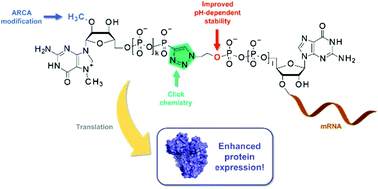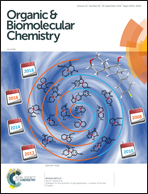Exploring the potential of phosphotriazole 5′ mRNA cap analogues as efficient translation initiators†
Abstract
Augmenting the mRNA translation efficiency and stability by replacing the standard 7-methylguanosine 5′-cap with properly designed analogues is a viable strategy for increasing the in vivo expression of proteins from exogenously delivered mRNA. However, the development of novel cap analogues with superior biological properties is hampered by the challenges associated with the synthesis of such highly modified nucleotides. To provide a simpler alternative to traditional methods for cap analogue preparation, we have recently proposed a click-chemistry-based strategy for the synthesis of dinucleotide cap analogues and identified several triazole-containing compounds with promising biochemical properties. Here, we further explored the concept of CuAAC-mediated cap synthesis by designing and studying ‘second generation’ triazole-modified caps, which were derived from the most promising ‘first generation’ compounds by modifying the oligophosphate chain length, altering the position of the triazole moiety, or replacing chemically labile P–N bonds with P–O bonds. The biochemical properties of the new analogues were evaluated by determining their affinity for eIF4E, susceptibility to hDcp2-catalysed decapping, and translation efficiencies in vitro and in cultured cells. The results led to identification of cap analogues that have superior translational properties compared to standard caps and the parent triazole-modified compounds as well as provided directions for future improvements.

- This article is part of the themed collection: Chemical Biology in OBC


 Please wait while we load your content...
Please wait while we load your content...